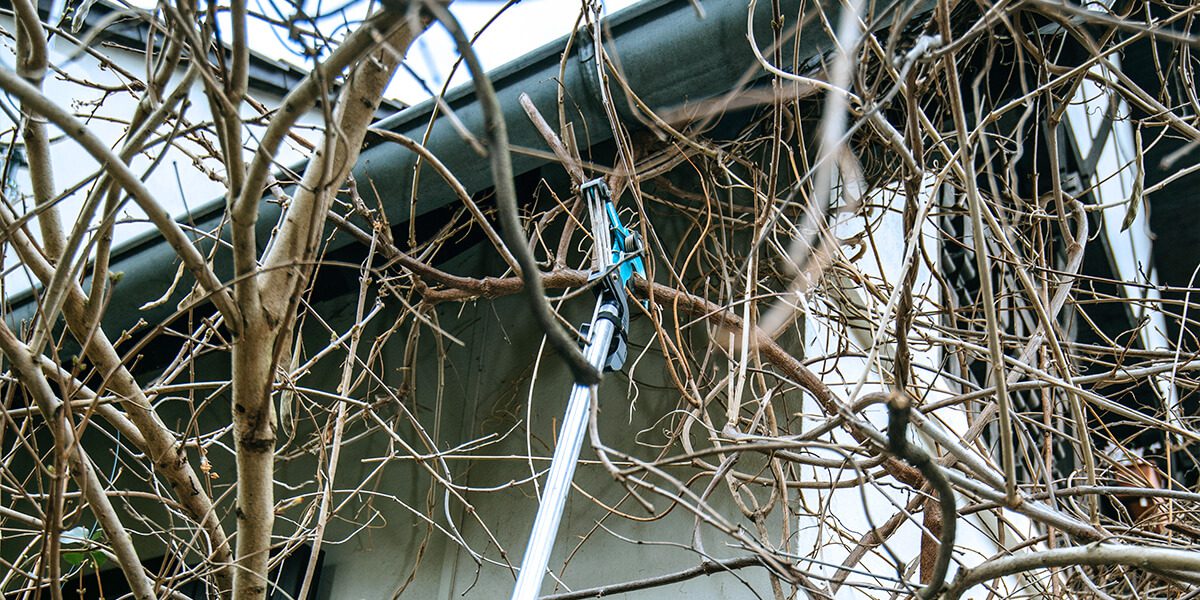It’s easy to be enraptured by the lilac blossoms of a wisteria, but these flowering vines are such vigorous growers that they can spread out of control. They’re known to choke out trees and damage buildings, but that shouldn’t stop us from growing them. Regular pruning can keep them in shape, while allowing us to drink in the beauty of their fragrant flowers.

Wisteria Pruning Part 1: After Flowering
The most successful way to keep a wisteria from spreading out of control is to prune it twice per year. The first pruning should happen after the flowers fade in early to mid-summer, and when the shoots of this year’s growth start to look unruly. The aim is to keep new growth close to the main vine and clear away unwanted shoots or suckers, as follows:
- Prune shoots of new growth to 6 inches in length.
- Remove any suckers from the roots.
- Prune shoots that are not needed for the main framework of the vine.
Since flowers form on one-year-old growth, this system of pruning not only maintains a tightly-shaped vine, but also allows the flowers to be visible the following year.

Wisteria Pruning Part 2: Winter
Even after pruning in early summer, a wisteria can still stretch its limbs a good distance in the remaining growing months. To keep it from sprawling out of control, it’s good to prune it again in late winter. Without the leaves, it’s easy to see which branches are essential to the main vine, and to remove unwanted growth, as follows:
- Prune lateral branches off the main trunk, including those you cut back in summer, down to 3-5 buds in length. This will direct the energy to new flowers, rather than new vegetation.
- Once again, you can remove any crowded or unruly branches that deviate from the main shape of the vine.

Pruning Wisterias into Alternative Styles
If you follow the advice above, your wisteria will have a tidy and civilized look. If you’re aiming for a wilder style, but still want it under control, just remember to prune out half of the growth each winter. And keep in mind that trimming the branches down to 2-3 buds spurs the biggest, most visible flowers the following spring. After flowering, you can touch up the vine with more pruning as needed.

How to Train a Wisteria
The most successful way to keep a wisteria from spreading out of control is to prune it twice per year.
When they’re not growing wildly out of control, wisterias can form beautiful archways across a pergola and make great privacy screens. The first step to training them is to ensure your structure is made of sturdy wood or metal, as wisterias are known to crush flimsy supports. When you’re training a new vine, select 2-3 young shoots to twine around each other up the pole. As they age, the twisted and gnarled trunks will become a main source of interest. Tie them close to the structure as they grow, but remove the twine once they can support themselves.

How Do You Deal with an Overgrown Wisteria?
When you let a wisteria grow out of control, you’re often left with a tangle of dead and misshapen branches that may or may not bloom. Restoring a wisteria into a blooming vine with a manageable size may take up to a year of cutting and pruning. Here are the steps to follow:
- Trim away dead and dying branches to the nearest healthy wood.
- Cut back suckers from the base, leaving one or two main trunks.
- Remove crowded lateral branches growing off the main trunk.
- Cut back remaining lateral branches after flowering.
- If the length of the vine is too tall, cut the top of the main trunk down to 4-6 feet, or to the length desired.
Once your wisteria is back in shape, keep pruning it twice per year in the size you desire. With regular pruning, you’ll not only keep your wisteria from spreading out of control, but will enjoy the most blossoms each spring as well!
For more advice on keeping plants under control, or to talk to any of our gardening experts, come out to our nurseries in Bloomingdale and Carpentersville!
ADDITIONAL READING:
Time to Say Goodbye to Your Tree: Tree Removal
Platt Hill Nursery is Chicago’s premier garden center and nursery.


